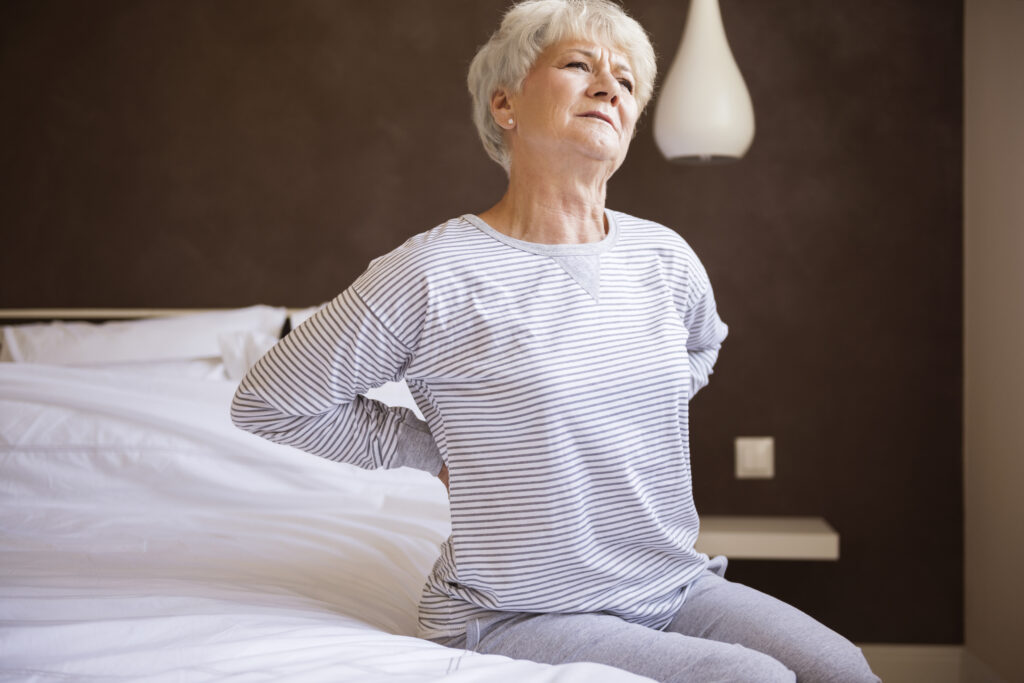 We generally think of our bones as solid, and the strongest part of our body, but new bone tissues are always growing, and old ones are always breaking down. But, as we get older, our bodies tend to lose more bone mass than they gain, and certain factors leading to this loss can negatively impact bone health. And one such factor is the menopause.
We generally think of our bones as solid, and the strongest part of our body, but new bone tissues are always growing, and old ones are always breaking down. But, as we get older, our bodies tend to lose more bone mass than they gain, and certain factors leading to this loss can negatively impact bone health. And one such factor is the menopause.
On average, women lose as much as 10%–20% of their bone mass in the first 5-6 years after menopause. And so, understanding this connection is crucial for implementing preventive measures and treatments to maintain optimal bone health during and after menopause. This post will discuss everything about menopause and its relation to bone health, research insights, testing for bone density, and the treatment options available.
What Does Research Say?
The Study of Women’s Health Across the Nation (SWAN) conducted by Greendale et al. (2012) found that white women experienced an average annual bone density decline of 2.5% in the lumbar spine and 1.8% in the femoral neck.
These declines were directly linked to changes in estradiol (E2) and follicle-stimulating hormone (FSH) levels (both of which help regulate the menstrual cycle). The study also noted that there wasn’t a significant decline in bone density before the transmenopause period.
How Does Menopause Affect Bone Health?
As discussed above, bone density starts to drop with lowering levels of estrogen around the time of menopause (between the ages of 45 and 55). And this estrogen level continues to decrease after menopause as well. This increases the risk of developing bone health-related disorders like osteopenia (low bone mineral density) and osteoporosis.
Symptoms include –
- Seeing a reduction in height by an inch or more
- Constantly stooping or bending forward
- Lower back pain (in your lumbar spine)
- Shortness of breath (in extreme conditions – if disks in your spine are compressed enough to reduce your lung capacity)
Other Risk Factors
Apart from hormonal changes, other factors and metabolic conditions such as insulin resistance, high BMI (obesity), and inflammatory conditions may also increase the risk of fractures and reduce bone strength, thus impacting bone density loss during and after menopause.
Moreover, it was also seen that the postmenopausal decline in bone mineral density was lesser than that in the transmenopause phase, emphasizing the importance of early intervention to reduce bone mass density loss in premenopausal and transmenopause women.
Bone Density Testing
A bone density scan (known as DXA or DEXA scan) is a special X-ray used to diagnose osteoporosis. Your DEXA scan measures the bone density (thickness of the bone), usually around the lower spine and upper part of the hip.
It is determined using two scores, as explained below.
T-score: Your T-score is the difference between your bone density and the average bone density of healthy 25-35-year-old adults of your same sex and ethnicity.
- A score of -1 and higher is considered normal.
- A score of between -1 and -2.5 indicates osteopenia.
- A score of -2.5 and lower indicates osteoporosis.
Z-score: Your Z-score is the difference between your bone density and the normal bone density of someone your age, sex, ethnicity, height, and weight. If your Z-score is significantly higher/lower than the average, additional tests might be required to determine the cause of the problem. Consider consulting with a doctor regarding the same if necessary.
It is recommended for women to have a DEXA scan if:
- Her age is above 65 years or older
- She breaks a bone after age 50
- She is a post-menopausal woman younger than 65 years
The Right Time for Intervention
With this rapid decline in bone density during the transmenopause phase, it’s very important to begin early lifestyle changes to reduce bone mass density loss in women. Physical activity, especially weight training, regular workouts, and proper nutrition, play a vital role in maintaining bone health during this phase.
The Role of Right Exercises
A study by Gonzalo-Encabo et al. (2019) highlighted that postmenopausal women who chose to walk to stay active and maintain bone health did not show significant improvements in BMD (Bone Mass Density).
On the other hand, those who practiced high-impact exercises and resistance training regularly showed greater improvements in bone density due to better mechanical loading and muscle tension while exercising.
The Role of Nutrition
Proper nutrition is equally important in maintaining bone health after menopause. Studies by Karlamangla et al. (2018) show that women aged 48.5 years with vitamin D serum levels below 20 ng/mL can suffer from an 85% higher risk of fractures. Since vitamin D is important for the active absorption of calcium in the gut to maintain enough serum calcium and phosphate concentrations in the body, ensuring adequate intake of calcium and vitamin D is essential.
Aim to eat at least 1,200-1,300 mg of calcium every day. Good sources of calcium include firm milk, yoghurt, cheese, tofu, almonds, dark green leafy vegetables, broccoli, and fish with edible bones.
For adults aged 19-70, it’s recommended to aim for at least 600 international units (IU) of vitamin D daily. If you’re over 70, it is recommended to increase your intake to 800 IU per day. The primary source of Vitamin D is sunlight. Some other dietary sources of vitamin D include fatty fish (like trout, salmon, tuna, and mackerel) and fish liver oils. However, supplements of calcium and vitamin D are also available if required.
Other Treatment Options Available
There are a variety of treatments available to help stop the deterioration of bone health and bone fragility. Here are some steps you can take to support bone health:
Prescription Medications and Injectable Agents
Certain groups of drugs like bisphosphonates and monoclonal antibodies are used to prevent bone loss. Over time, these drugs have been shown to slow down bone loss, increase bone density, and lower the chances of getting bone fractures. Monoclonal antibodies include drugs like denosumab and romosozumab, also known as Evenity.
Selective estrogen receptor modulators, or SERMs have estrogen-like properties, which are also used for the prevention and treatment of osteoporosis.
Hormone Replacement Therapy (HRT)
HRT involves the addition of hormones in the body that are lost during the menopausal transition. It can also help to prevent bone loss caused by the decreased levels of estrogen that occur during the perimenopause and menopause phases.
However, it’s best to consider other available options before considering HRT. HRT might not be the right choice if you have a history of certain conditions or are at an increased risk for:
- Heart attack
- Stroke
- Blood clots
- Breast cancer
There are other health conditions as well where HRT might not be a suitable option. It’s important to consult your doctor to get more details about this treatment option.
Conclusion
Menopause is a good time to reflect on positive lifestyle changes you can make to better take care of your bone health. Make sure to follow a healthy diet plan, including a wide range of food groups to give your bones all the nutrients they need. Make sure you’re getting plenty of protein, calcium, and vitamin D to support bone health.
Consider taking vitamin D supplements in the winter months when you can’t top up from the sun. Commit to regular weight-bearing along with aerobic exercises to keep your bones strong and maintain good balance.
Want to understand the various aspects of women’s health and wellness?
Enroll now in our Women’s Health and Wellness course!
References
Ji, M. X., & Yu, Q. (2015). Primary osteoporosis in postmenopausal women. Chronic diseases and translational medicine, 1(01), 9-13.
Byun, J. H., Jang, S., Lee, S., Park, S., Yoon, H. K., Yoon, B. H., & Ha, Y. C. (2017). The efficacy of bisphosphonates for prevention of osteoporotic fracture: an update meta-analysis. Journal of Bone Metabolism, 24(1), 37.
What Is Menopause?
https://www.nia.nih.gov/health/menopause/what-menopause
Calcium
https://ods.od.nih.gov/factsheets/calcium-HealthProfessional/
Vitamin D
https://ods.od.nih.gov/factsheets/VitaminD-Consumer/
Simas, V., Hing, W., Pope, R., & Climstein, M. (2017). Effects of water-based exercise on bone health of middle-aged and older adults: a systematic review and meta-analysis. Open access journal of sports medicine, 39-60.
Chan, C. C. (2016). Selective estrogen receptor modulators. Gynecological Drug Therapy, 105-110.
Greendale, G. A. et al. (2012) ‘Bone mineral density loss in relation to the final menstrual period in a multiethnic cohort: Results from the Study of Women’s Health Across the Nation (SWAN)’, Journal of Bone and Mineral Research, 27(1), pp. 111–118. doi: 10.1002/jbmr.534.
Gonzalo-Encabo, P. et al. (2019) ‘Dose-response effects of exercise on bone mineral density and content in post-menopausal women’, Scandinavian Journal of Medicine and Science in Sports, 29(8), pp. 1121–1129. doi: 10.1111/sms.13443.
Karlamangla, A. S., Burnett-Bowie, S. A. M. and Crandall, C. J. (2018) ‘Bone Health during the Menopause Transition and Beyond’, Obstetrics and gynecology clinics of North America, 45(4), p. 695. doi: 10.1016/J.OGC.2018.07.012.
Yang, Chung-Yuan, et al. “Effects of sex, tobacco smoking, and alcohol consumption osteoporosis development: Evidence from Taiwan biobank participants.” Tobacco Induced Diseases 19 (2021).
